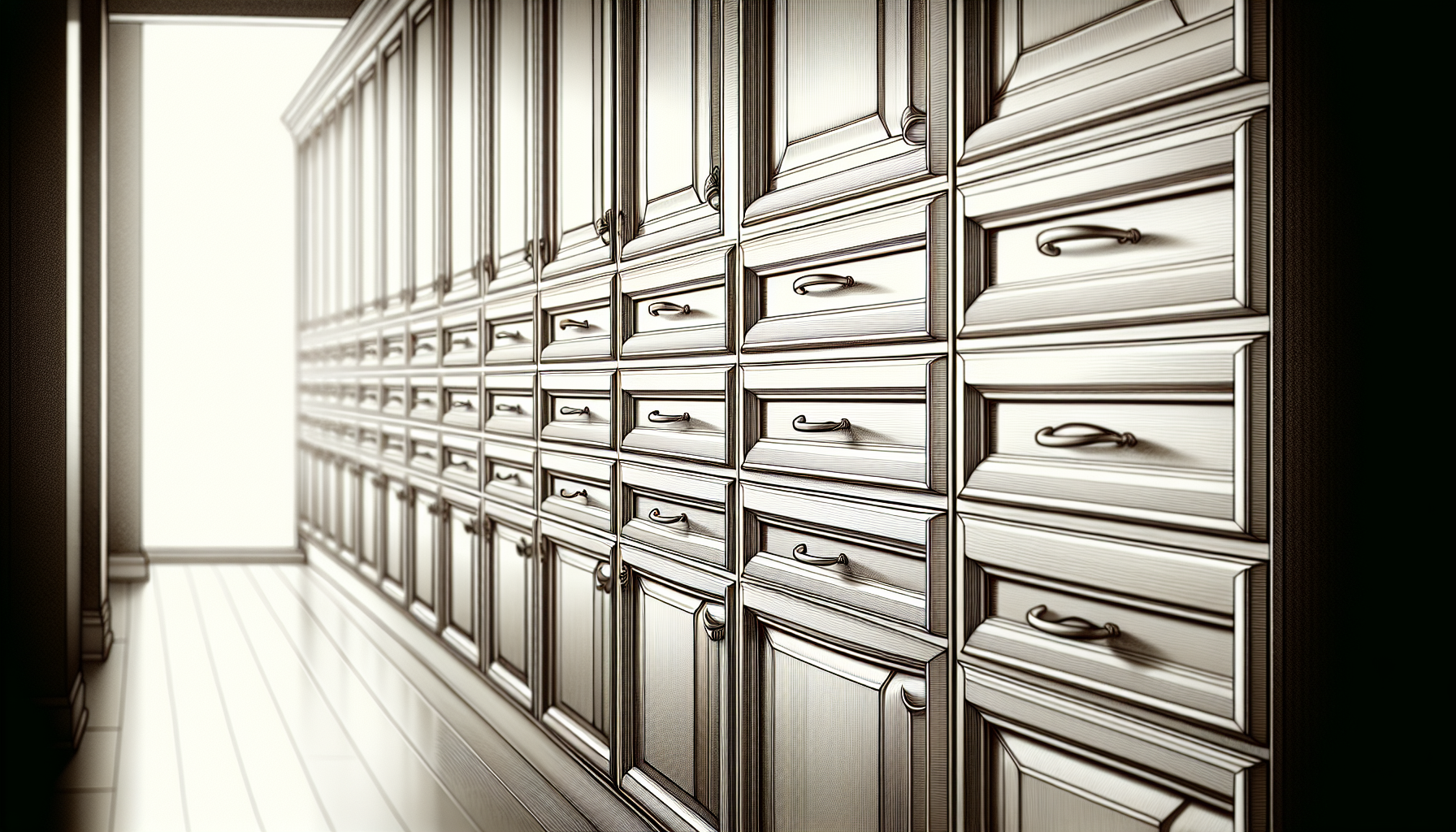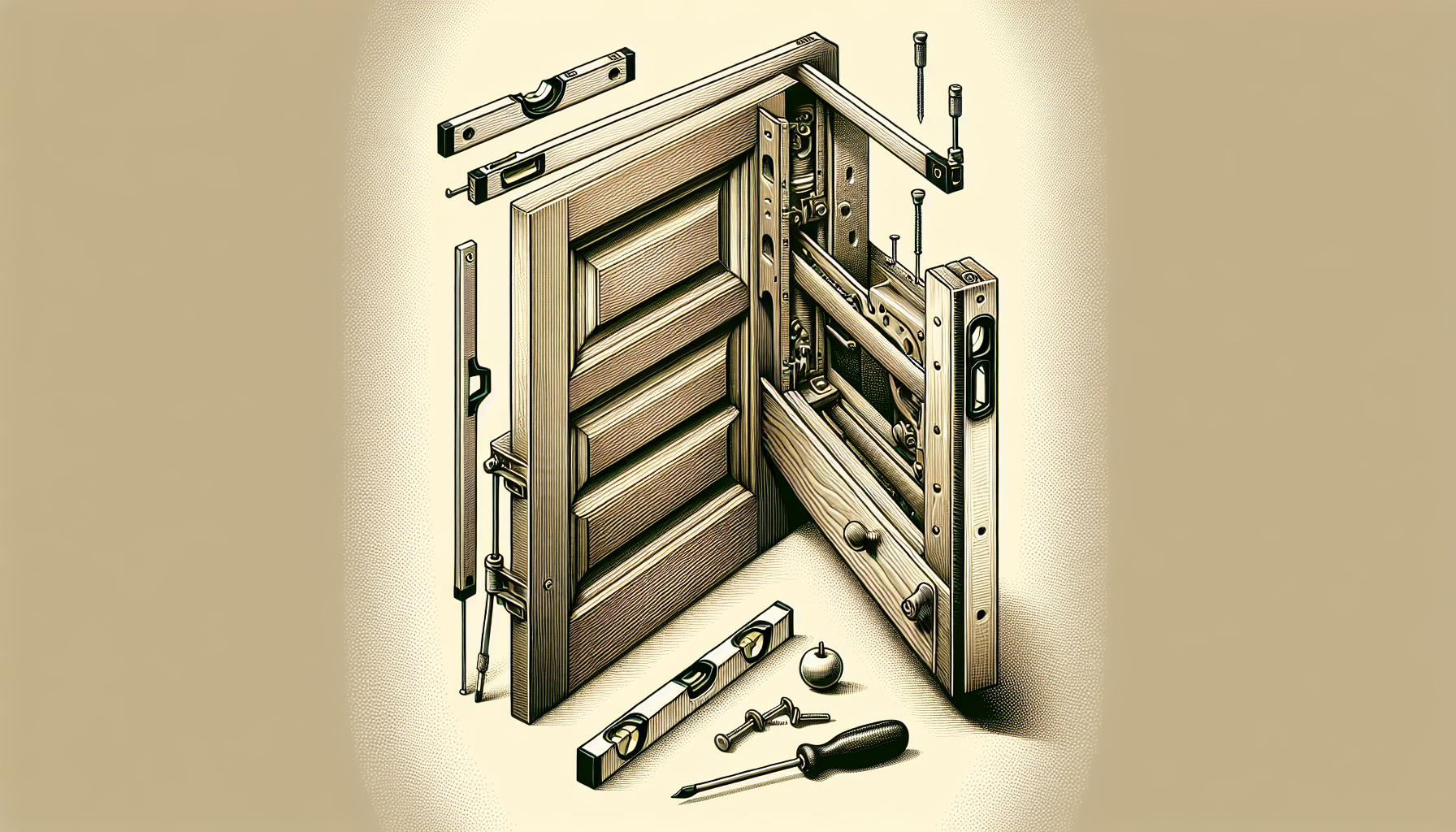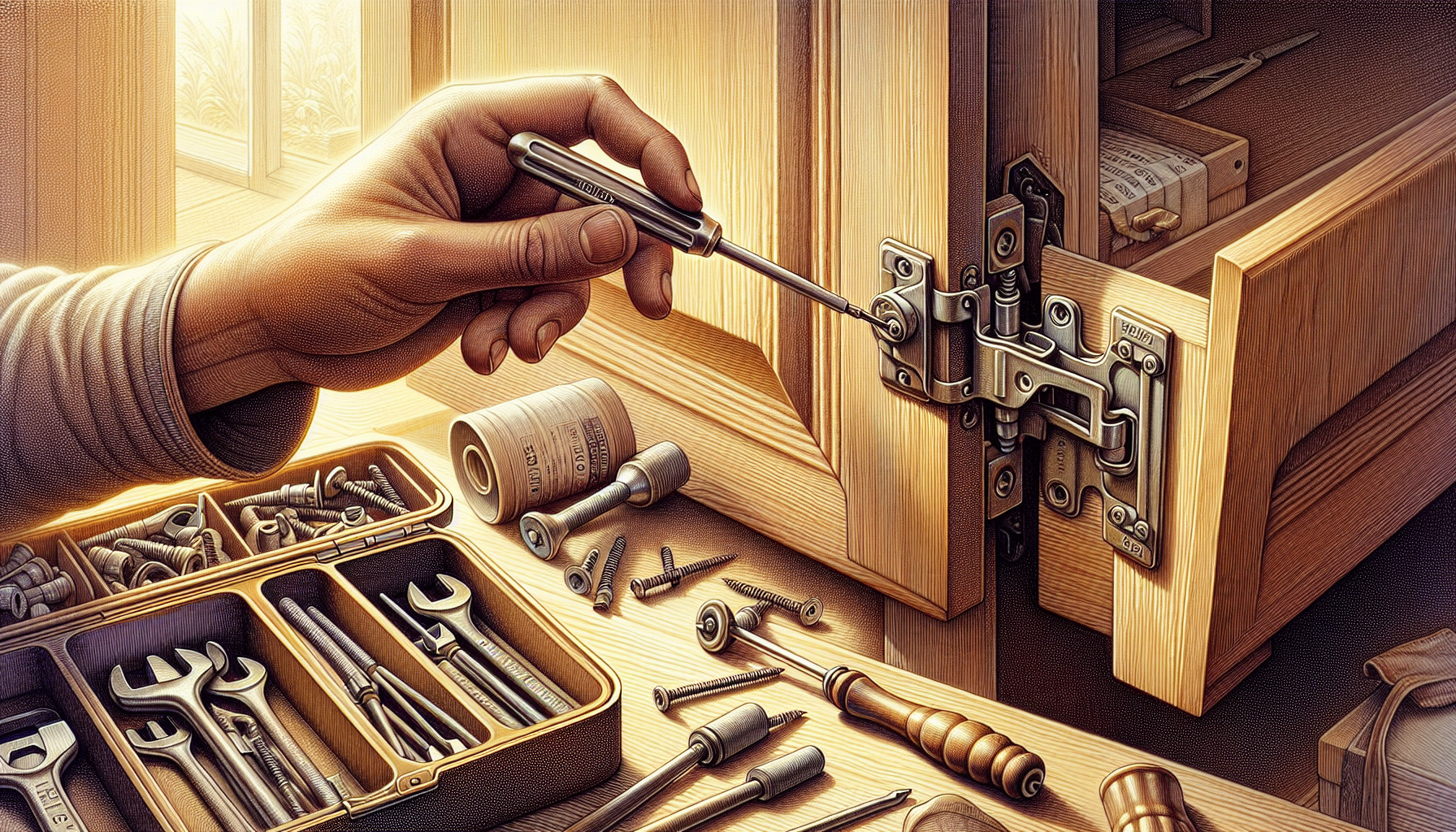If your kitchen cabinet doors are misaligned or sagging, adjusting the hinges can fix the problem. This article will show you how to inspect your hinges, gather the right tools, and make adjustments for perfect alignment.
Key Takeaways
- Gather the right tools and inspect your cabinet hinges before making any adjustments.
- Adjusting the cabinet door height, alignment, and depth can fix common issues like sagging, misalignment, and jamming.
- Regular maintenance, including tightening screws and lubricating hinges, can extend the lifespan and functionality of your cabinet doors.
Preparing for Adjustment

Adequate preparation is required before starting to adjust kitchen door hinges. Kitchen cabinet doors can become loose and misaligned due to daily use, temperature changes, and humidity fluctuations. Understanding the importance of hinge adjustment helps in achieving a neat finish for your cabinet doors.
Sagging is the most common issue, but with the right tools and a bit of patience, you can correct it yourself.
Gather Your Tools
A Phillips-head screwdriver with a #2 screw tip is required to get started, as it’s the only tool necessary for this task. While a power drill might seem like a quick fix, it’s best avoided to prevent over-tightening. If your cabinets are particularly tall, a stepladder can also be handy for reaching those upper hinges.
Inspect Your Hinges
Inspection of your hinges should be carried out before making any adjustments. Identify the type of hinges on your cabinets, as this will determine the adjustments you can make. Ensure that all mounting screws are secure to avoid further issues during the adjustment process.
Understanding whether you have 3-way hinges, which allow for depth, side-to-side, and elevation adjustments, can also be beneficial.
Adjusting the Cabinet Door Height

Adjusting the height of your cabinet doors is often necessary to correct sagging or uneven gaps. Here’s how to do it:
- Open the cabinet door and locate the hinge with two vertical screws.
- Loosen these screws to allow for the door to be moved up or down, achieving the desired height.
- For precise adjustments, move the door incrementally and check the alignment by closing the doors periodically.
Locate Vertical Screws
The first step in adjusting the height is to locate the vertical screws on the hinge. These screws are typically found on the portion of the hinge attached to the cabinet frame.
Most hinges have two vertical screws that need to be identified before making any height adjustments using hinge adjustment screws.
Loosen and Adjust
After locating the vertical screws, follow these steps to adjust the door height:
- Slightly loosen the screws to facilitate movement without detaching the door from the hinge.
- Adjust the door to the desired height.
- Retighten the screws to secure the door in its new position.
This up-and-down adjustment can make a noticeable difference in the alignment of your cabinet doors, so it’s essential to know how to adjust cabinet doors properly.
Aligning the Cabinet Doors Side-to-Side

Aligning your cabinet doors side-to-side is necessary for a tidy finish. This adjustment moves the doors left and right, ensuring they line up perfectly with their neighbours or the edges of the cabinet box. This process involves locating and adjusting the side-to-side screw, often found near the centre of the hinge.
Find the Horizontal Adjustment Screw
Start by finding the horizontal adjustment screw to adjust cabinet hinges. It is typically positioned closest to the cabinet front. On soft-close hinges, this screw functions similarly to regular hinges for side-to-side adjustments. Turning this screw clockwise will move the door closer to the cabinet edge, while counterclockwise will move it toward the middle.
Adjust Horizontally
Upon identifying the horizontal screw, small adjustments should be made to both the top and bottom hinges to shift the doors left or right. This ensures proper alignment and prevents misaligned doors.
Tighten the horizontal locking screw on the hinge’s right side inside the cupboard to secure the door once the adjustment is complete.
Adjusting the Depth of Cabinet Doors

Adjusting the depth is vital to ensure the smooth opening and closing of your cabinet doors without any jamming. The depth adjustment screw allows the door to be moved in and out with the cabinet box. This feature helps to achieve precise positioning and alignment.
Proper depth adjustment prevents doors from bouncing when they close and ensures they sit correctly when shut.
Locate the Depth Adjustment Screw
Begin by locating the depth adjustment screw, typically found in the centre of modern concealed hinges. On a 3-way hinge, this screw moves explicitly the door in or out from the cabinet face.
Fine-Tune the Depth
To adjust the depth of each door hinge, follow these steps:
- Loosen the centre screw on each door hinge.
- To move the door further from the cabinet box, rotate the screw clockwise.
- Alternatively, turning the screw counterclockwise will pull the door closer.
Fine-tuning these adjustments will ensure the door operates smoothly without catching on the frame.
Tightening Loose Cabinet Doors

Loose cabinet doors can disrupt the overall functionality and aesthetics of your kitchen. To tighten loose doors, start by tightening all door and cupboard screws, including those on the cupboard door. This can fix loose cabinet doors and prevent them from becoming misaligned again.
Secure Mounting Screws
Mounting screws, such as two mounting screws, can be secured by turning them clockwise using a Phillips-head screwdriver. Periodically tightening these screws helps maintain hinge functionality and prevents sagging.
If you notice the top hinge is loose, push the door up and back to straighten it and then proceed to tighten the screws. This will ensure the door is properly adjusted and secure in place.
Check All Hinges
Inspect each set of cabinet door hinges, including kitchen door hinges, to ensure they are in good condition. Tightening both the fixed door hinges screws and the adjustable cupboard screws will prevent any looseness and maintain proper alignment.
Troubleshooting Common Issues
Despite careful adjustments, common issues such as crooked doors or doors that don’t close properly might still occur. Bent hinges or obstructions inside the cabinet can cause these problems. In such cases, consider tweaking all doors to ensure consistent spacing.
Fixing Crooked Doors
To fix crooked doors, remove the door from the hinges to get a better view of any rubbing or catching areas. Examine the door alignment and adjust the screws on the hinges for proper positioning.
Addressing Doors That Won't Close Properly
For doors that won’t close properly, check and adjust the hinge screws to move the door forward or backwards. On soft-close hinges, adjust the spring tension to ensure the door closes fully. This can often resolve issues with doors sticking or not closing properly.
Maintaining Your Cabinet Hinges
The longevity of your cabinet hinges relies on regular inspections and damage prevention. Check and adjust your hinges every few months to ensure they are functioning smoothly.
Regularly cleaning and lubricating hinges can prevent dirt buildup and reduce wear.
Regular Inspections
Cabinet hinges should be inspected every three to six months. Periodically tighten hinge screws as they can loosen over time due to everyday use.
Checking for any misalignment due to wear or heavy usage helps maintain proper door alignment.
Avoiding Damage
Avoid overloading hinges, and clean them regularly to prevent dirt and grime buildup. Lubricate hinges at least once a year to prevent rust and wear.
If you notice any signs of damage or rust, consider replacing the hinges to maintain optimal performance.
Summary
Adjusting kitchen cabinet hinges may seem daunting at first, but with the right tools and knowledge, it becomes a manageable task. By following these steps, you can ensure your cabinet doors are aligned, functional, and aesthetically pleasing. Regular maintenance and careful adjustments will keep your kitchen looking and working at its best. So, grab that Phillips-head screwdriver and give your cabinets the attention they deserve!
Frequently Asked Questions
Q: What tools do I need to adjust kitchen cabinet hinges?
A: You'll need a Phillips-head screwdriver to adjust kitchen cabinet hinges. Optionally, a stepladder can be helpful for higher cabinets.
Q: How often should I check my cabinet hinges?
A: You should check your cabinet hinges every three to six months to ensure they are working properly. This will help maintain smooth function.
Q: Why are my cabinet doors sagging?
A: Your cabinet doors are probably sagging because of loose screws or misalignment caused by regular use and temperature changes. Make sure to tighten the screws and adjust the alignment to fix the issue.
Q: Can I use a power drill to adjust my cabinet hinges?
A: No, it's better to use a Phillips-head screwdriver to adjust your cabinet hinges to prevent over-tightening. This can avoid any damage and ensure a proper adjustment.
Q: What should I do if my cabinet doors don't close properly?
A: You should adjust the hinge screws or tension and check for any obstructions inside the cabinet to fix the issue with the doors not closing correctly.
